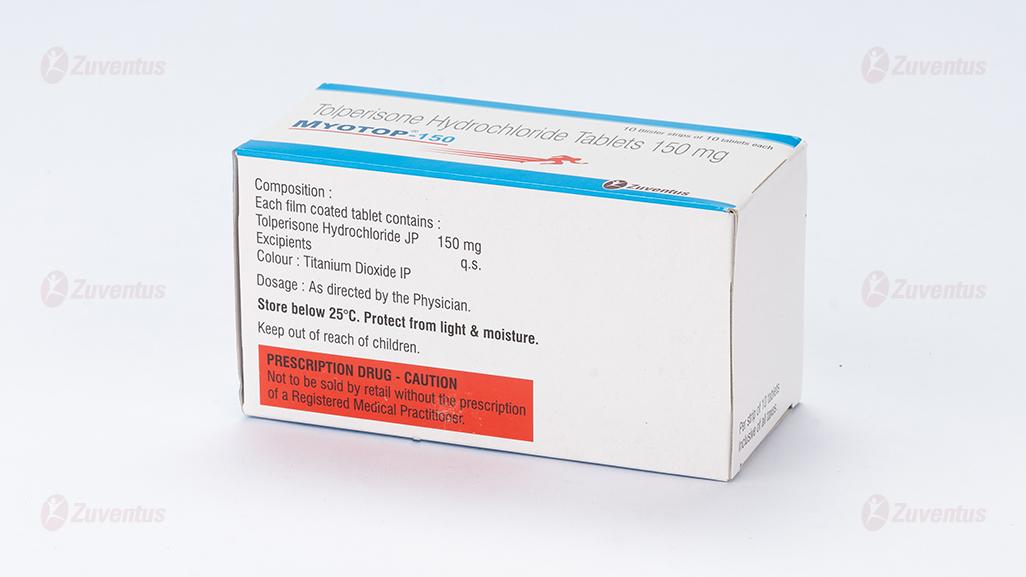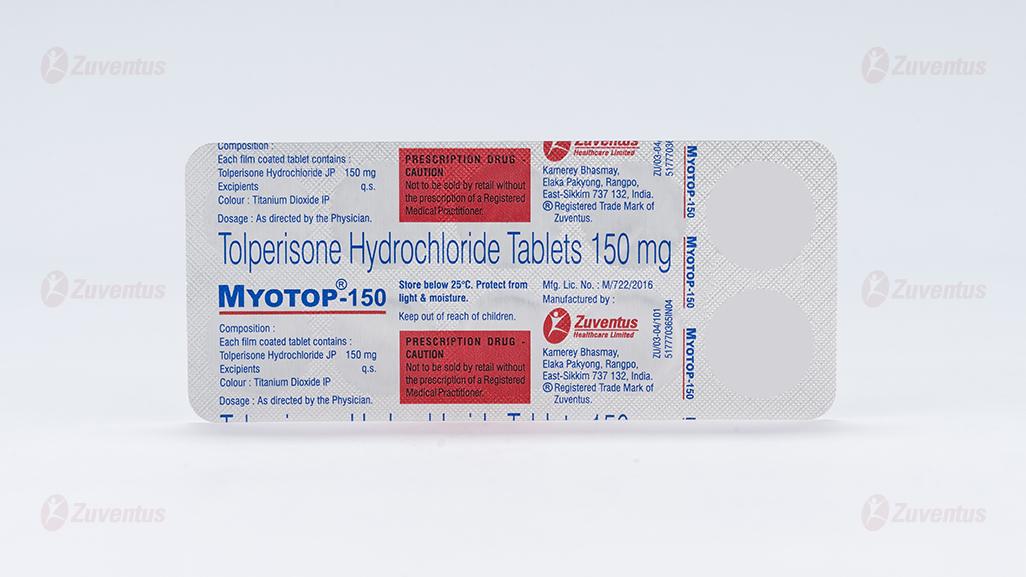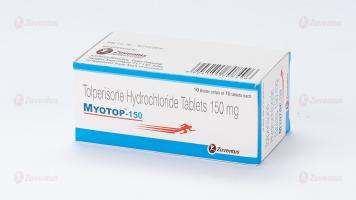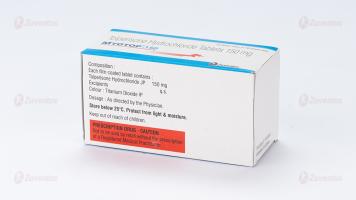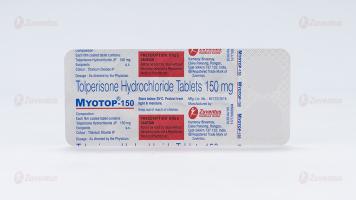MYOTOP®-150 Tablets
Therapy Area
Pain management
1.0 Generic Name
Tolperisone Hydrochloride Tablets 150 mg
2.0 Qualitative and Quantitative Composition
Composition:
Each film coated tablet contains:
Tolperisone Hydrochloride 150 mg
Excipients q.s.
Colour: Titanium Dioxide IP
3.0 Dosage form and strength
Film-coated tablets
150 mg
4.0 Clinical particulars
4.1 Therapeutic Indications
For the relief of painful muscle spasm of the skeletal musculature
4.2 Posology and method of administration
Route of administration
For oral use
The drug should be taken after a meal with a glass of water. Insufficient food intake may reduce the bioavailability of Tolperisone. The dosage and administration of Tolperisone must be as prescribed by the physician.
The recommended dose is as follows:
Adult: One tablet 1 to 3 times daily (150 mg to 450mg) according to the individual requirement and tolerance of the patient.
Careful individual dose titration based on the therapeutic effect and tolerability of the patient is recommended.
Patients with renal impairment
Experience in patients with impaired renal function is limited and this group of patients was observed higher incidence of adverse effects. Therefore, in patients with moderate renal impairment recommends individual titration and careful monitoring of patient status and renal function. In patients with severe renal impairment is not recommended for use tolperisone.
Patients with hepatic impairment
Experience in patients with hepatic impairment is limited, and this group of patients was observed higher adverse effects. Therefore, in patients with moderate hepatic impairment is recommended individual titration and careful monitoring of patient status and liver function. In patients with severe hepatic impairment is not recommended for use tolperisone.
Paediatric population
Children (from 3 months to 6 years): 5-10 mg/kg/day in 3 divided doses.
Children (from 6 to 14 years): 2-4 mg/kg/day in 3 divided doses.
4.3 Contraindications
- Hypersensitivity to the active substance or to any of the excipients.
- In patients suffering from myasthenia gravis.
-Tolperisone should not be given during breast-feeding.
-Precautions have to be taken when tolperisone is used together with other muscle relaxants.
4.4 Special warnings and precautions for use
Hypersensitivity reactions
During Postmarketing surveillance hypersensitivity reactions occurred in the range from mild skin reactions to severe systemic reactions. Symptoms may include erythema, rash, urticaria, pruritus, angioedema, tachycardia, hypotension, or dyspnea. Higher risk can be for women, in patients with hypersensitivity to other drugs or with a history of allergies.
When administered tolperisone caution should be exercised in cases of known hypersensitivity to lidocaine because of possible cross-reactions.
Patients should be advised to carefully watch for any symptoms suggestive hypersensitivity, and if these symptoms stop taking tolperisone and immediately sought medical assistance.
Tolperisone not be re-administered after the occurrence of episodes of hypersensitivity to tolperisone
Pregnancy
In the absence of relevant clinical data, Myotop not to be taken during pregnancy (especially in the first trimester), unless the expected benefit clearly justifies the potential risk to the fetus.
4.5 Drug Interactions
Interaction, which would limit the administration Myotop 150 are not known.
Although tolperisone (centrally active substance), does not cause sedation. It may therefore be administered with hypnotics, sedatives and tranquilizers. However, it is considered possible to reduce the doses of tolperisone in combination with other centrally acting muscle relaxants.
Tolperisone has no influence on the CNS effects of alcohol.
Tolperisone potentiates the effect of niflumic acid, thus reducing the dosage niflumic acid and other NSAIDs when co-administered with the preparation Myotop.
4.6 Pregnancy and lactation
Pregnancy:
In experiments on laboratory animals were observed a teratogenic effect of tolperisone. As a result of lack of adequate clinical data preparation Myotop not be administered during pregnancy (Especially in the first trimester), unless the expected benefit clearly outweighs the potential risk to the fetus.
Breastfeeding:
It is not known whether tolperisone is excreted in breast milk. Administration tolperisone during lactation is contraindicated.
4.7 Effects on ability to drive and use machines
MYOTOP®-150 does not affect the ability to drive or operate machinery. If, however, some patients experience side effects such as dizziness and weakness or muscle, is not advisable to drive or operate machinery.
4.8 Undesirable effects
MYOTOP®-150 has a very good safety profile, which is supported by the results of retrospective studies which include data from more than 10,000 patients. Most cases involved non-serious and self-limited conditions. Very rarely were reported life-threatening hypersensitivity reactions.
The following summary consists of side effects reported in clinical studies and those that would be observed and reported in post-marketing studies.
| MedDRA class organ systems | Uncommon (> 1/1000, <1/100) | Rare (> 1/10000, <1/1000) | Very rare (<1/10000) |
| Blood disorders and lymphatic system | Anemia, lymphadenopathy | ||
| Immune System | hypersensitivity reactions anaphylactic reaction | anaphylactic shock | |
| Metabolism and nutrition | anorexia | polydipsia | |
| Psychiatric Disorders | insomnia sleep disorders | decreased activity depression | |
| Nervous System | headache dizziness somnolence | attention deficit disorders tremor epilepsy hypoesthesia paresthesia lethargy | |
| Eye disorders | blurred vision | ||
| Ear and labyrinth disorders and labyrinth disorders | tinnitus vertigo | ||
| Cardiac disorders | angina tachycardia palpitation | bradycardia | |
| Vascular disorders | hypotension | redness | |
| Respiratory, pectoral and mediastinal disorders | dyspnoea epistaxis tachypnoe | ||
| Gastrointestinal disorders | abdominal discomfort diarrhea dry mouth dyspepsia nausea | Epigastric pain constipation flatulence vomit | |
| Liver disorders and biliary tract | mild liver damage | ||
| Skin and subcutaneous tissue disorders | allergic dermatitis increased sweating pruritus urticaria rash | ||
| Renal and urinary tract | enuresis proteinuria | ||
| Musculoskeletal system and connective tissue | muscle weakness myalgia limb pain | limb discomfort | osteopenia |
| Total and elsewhere disorders and local reactions after administration | asthenia discomfort fatigue | feeling drunk feelings of warmth irritability thirst | chest discomfort |
| Investigations and laboratory findings Not Elsewhere Classified | reduced blood pressure Elevated bilirubin in the blood changes in liver enzymes reduced number of platelets elevated white blood cell count | increased creatinine in Blood |
4.9 Overdose
Data on overdose with MYOTOP®-150 is limited. Myotop has a high therapeutic index. As is known from the literature, 600 mg oral dose may be administered to children without the raised severe toxic symptoms. In some cases, the administration of daily oral doses of 300-600 mg for children causes irritability. In preclinical tests for acute toxicity at high doses appeared- ataxia, tonic-clonic convulsions, paralysis and shortness of breath.
Tolperisone doesn’t have special antidote, in case of overdose, symptomatic and supportive treatment recommended.
5.0 Pharmacological Properties
5.1 Mechanism of action/ Pharmacodynamic properties
Pharmacotherapeutic group: centrally acting muscle relaxant. ATC group: M03BX04.
Tolperisone is a centrally acting muscle relaxant with local anesthetic properties. It possesses high affinity to nerve tissues reaching highest concentrations in the brain stem, spinal cord and peripheral nervous tissue. The most effect of tolperisone is its inhibitory activity in level spinal reflex pathways. This effect together with inhibitory influence descending control pathways might be of therapeutic importance of the main benefit of tolperisone.
The chemical structure of molecules of tolperisone is very close to the structure of lidocaine. Tolperisone like lidocaine also has a stabilizing effect on cell membranes and reduces the electrical excitability of motor neurons, and primary afferent. Tolperisone concentration-dependently reduced influx of sodium Membranes isolated nerve cells and thus reduces the amplitude and frequency of action potentials.
Furthermore, it was found an inhibitory effect on voltage-gated calcium channels; This suggests that tolperisone would moreover to stabilize the membrane could even decrease transmitter release.
Tolperisone has also weak alpha-antagonist and anti-muscarinic properties.
5.2 Pharmacokinetic properties
After oral administration, tolperisone is absorbed well from the small intestine. The rate of absorption is rapid, the peak plasma concentration of tolperisone occurs at 0.5 to 1 hour after ingestion of Tolperisone tablets. The average oral bioavailability is about 20% though between-subject variability on systemic exposure is high; within-subject variability is relatively low. Since the absorption of the compound is virtually complete, the rather low and variable oral bioavailability may be the result of substantial first-pass metabolism
Tolperisone is only moderately (60 to 75%) bound to plasma proteins.
Tolperisone and its metabolites are excreted almost entirely through the kidneys. 98% of the administered dose is excreted in the urine within 24 hours. The total plasma clearance is 1.9±0.4 L/h/kg in human. The elimination half-life of tolperisone is 1-2.5 hours.
6.0 Non-clinical Properties
6.1 Animal toxicology and Pharmacology
Preclinical studies revealed based on conventional studies of safety pharmacology, toxicity repeatedly filed with tolperisone, genotoxicity and reproductive toxicity no special hazard for man. Effects in non-clinical studies were observed only at exposures considered sufficiently in excess of the maximum human exposure, indicating little relevance to clinical use. In reproductive studies in rats and rabbits tolperisone caused embryo changes in daily dose 500 mg / kg in rats and 250 mg / kg in rabbits. These benefits, however, far exceeds the recommended therapeutic dose.
7.0 Description
MYOTOP®-150 is a preparation of tolperisone hydrochloride. Tolperisone hydrochloride is an aromatic ketone. A centrally acting muscle relaxant that has been used for the symptomatic treatment of spasticity and muscle spasm.
Molecular Formula: C16H23NO·HCl
Chemical name: 4'-Methyl-2-(1-piperidinylmethyl)-propiophenone hydrochloride; 2,4'-Dimethyl-3-piperidinopropiophenone monohydrochloride
Molecular weight: 281.82
Structural Formula:

8.0 Pharmaceutical Particulars
8.1 Incompatibilities
Not applicable
8.2 Shelf life
24 months
8.3 Packaging Information
10 Blister strips of 10 tablets each
8.4 Storage and handling instructions
Store protected from light & moisture at a temperature not exceeding 25°C. Keep out of reach of children.
Read all of this leaflet carefully before you start taking this medicine, because it contains important information for you.
- Keep this leaflet. You may need to read it again.
- If you have any further questions, ask your doctor or pharmacist.
- This medicine has been prescribed for you only. Do not pass it on to others. It may harm them, even if their signs of illness are the same as yours.
- If you get any side effects, talk to your doctor or pharmacist. This includes any possible side effects not listed in this leaflet.
What is in this leaflet:
1. What MYOTOP®-150 is and what it is used for
2. What you need to know before you take MYOTOP®-150
3. How to take MYOTOP®-150
4. Possible side effects
5. How to store MYOTOP®-150
6. Contents of the pack and other Information
1. What is MYOTOP®-150 and what it is used for
MYOTOP®-150 contains Tolperisone as an active ingredient. Tolperisone is a medicine that acts on the central nervous system (brain and spinal cord). It is used to treat the pathological (disease-induced) increased skeletal muscle tone in adults. It provides relief from the discomfort associated with acute, painful musculoskeletal conditions such as rigidity, tension, stiffness, and skeletal muscle spasms.
2. What you need to know before you take MYOTOP®-150
Do not take MYOTOP®-150 if you:
- If your allergic to the active substance or to any of the other ingredients of this medicine.
- You suffer from myasthenia gravis (an autoimmune disease characterized by muscle weakness)
- You are Pregnant or breastfeeding.
When should you be extra careful with this medicine?
Hypersensitivity reactions
During post-marketing experience with medicinal products containing tolperisone (the active substance of this medicinal product) hypersensitivity reactions were reported. Hypersensitivity reactions ranged from mild skin reactions to severe systemic reactions. Women, elderly patients, or patients treated concomitantly with other drugs mainly NSAIDs (group of painkillers with a strong anti-inflammatory effect)) appear to be at a higher risk of hypersensitivity reactions. Also, patients with a drug allergy or allergic diseases or conditions (such as atopy: hay fever, asthma, atopic dermatitis with high serum IgE, hives) in the past or patients who simultaneously suffer from viral infections appear to be at greater risk of an allergic reaction to this medicine.
Early indications of hypersensitivity include: flushing, rash, severely itchy skin (with bumps), wheezing, difficulty breathing with or without swelling of the face, lips, tongue and/or throat, difficulty swallowing, fast heart rate, low blood pressure, rapid drop in blood pressure.
If you feel these symptoms, stop taking this medicine immediately and contact your doctor or the nearest emergency department.
If you have ever had an allergic reaction to tolperisone, you should not use this medicine. If you have a known allergy to lidocaine, you are more likely to be allergic to tolperisone. In this case, talk to your doctor before starting treatment.
Do not take the drug again if a hypersensitivity reaction occurs.
Other medicines and MYOTOP®-150.
If you are taking, or have you recently taken, any other medicines besides Tolperisone or the possibility that you will take other medicines in the near future? Please tell your doctor or pharmacist.
There are no data available on the dose-limiting interaction of this drug. Although tolperisone is a centrally acting agent, it does not cause sedation (it does not reduce your ability to concentrate). Therefore, it can be used at the same time as tranquilizers and sleeping pills. In case of co-administration with other centrally acting muscle relaxants, a dose adjustment of tolperisone should be considered.
Tolperisone enhances the effect of niflumic acid. Therefore, a dose reduction of niflumic acid or other nonsteroidal anti-inflammatory drugs (NSAID) should be considered in case of co-administration.
3. When taking MYOTOP®-150 with food and drink?
The consumption of food and drink does not affect the absorption of this medicine. It is important that you take the medicine after having eaten enough (after a meal).
Pregnancy and breastfeeding
Are you pregnant, do you think you are pregnant, do you want to become pregnant or are you breastfeeding? Please contact your doctor or pharmacist before using this medicine. Tell your doctor if you are pregnant or planning to become pregnant. Because there is no evidence that this drug could have a harmful effect on the fetus, your doctor should decide whether you should take this medicine after careful consideration of the benefit-risk balance, especially in the first three months of pregnancy. This medicine should not be used during breastfeeding.
Driving and using machines
The medicine does not affect the ability to drive or use machines. However, if you experience dizziness, drowsiness, disturbance in attention, epilepsy, blurred vision or muscle weakness while taking this medicine, consult your doctor.
How to take MYOTOP®-150.
Always take this medicine exactly as your doctor or pharmacist has told you. Are you unsure about the correct use? Please contact your doctor or pharmacist. The recommended dose is: 1 MYOTOP®-150 film-coated tablets 3 times a day. Take this medicine after meals with a glass of water.
Use in children and adolescents: kindly consult your doctor regarding dosages.
Patients with renal impairment
Your normal medical check-ups will include regular assessment of your renal function and general condition during treatment with this medicine, as an increase in side effects has been observed in this patient group. You should not take this medicine if you have severe kidney problems.
Patients with hepatic impairment
Your liver function and general condition will be regularly assessed during your normal medical check-ups during treatment with this medicine as an increase in side effects has been observed in this patient group. You should not take this medicine if you have severe liver problems.
Have you taken too much of this medicine?
Symptoms of overdose may include drowsiness, gastrointestinal symptoms (such as nausea, vomiting, upper abdominal pain), fast heart rate, high blood pressure, slow movement, and dizziness. In severe cases, seizures, slowing or cessation of breathing and coma have been reported.
If you take more of this medicine than prescribed by your doctor, contact your doctor or pharmacist immediately or go to the emergency department of your nearest hospital.
If you forget to take this medicine?
Do not take a double dose to make up for a forgotten tablet.
If you stop taking this medicine.
Do not stop taking the drug prematurely, even if you experience the effect of this drug as too strong or too weak. In that case, contact your doctor or pharmacist. Do you have any other questions about the use of this medicine? Please contact your doctor or pharmacist.
4. Possible side effects
Like all medicines, this medicine can cause side effects, although not everyone gets them. Most side effects are usually mild and disappear after treatment is stopped. Uncommon: occur in less than 1 in 100 patients. Rare: occur in less than 1 in 1000 patients Very rare: occurs in less than 1 in 10,000 patients (including individual cases).
Uncommon side effects: loss of appetite, insomnia, sleep disorders, headache, dizziness, drowsiness, low blood pressure, abdominal pain, diarrhea, dry mouth, indigestion, nausea, muscle weakness, muscle pain, pain in arms and legs, weakness, malaise (generally feeling unwell, feeling sick), fatigue.
Rare side effects: hypersensitivity reaction (allergic reaction), severe allergic reaction, decreased activity, depression, disturbance in attention, trembling hands, attack of unconsciousness with muscle twitching (convulsion), loss of sensation, sensory disturbance, lethargy, visual disturbance, vertigo, ringing in the ears, tightness in the chest, fast heartbeat, palpitations, reduced blood pressure (hypotension), flushing, shortness of breath, nosebleed, panting, pain in the stomach area, constipation, flatulence, vomiting, mild liver damage, allergic skin symptoms, increased perspiration, itch (pruritus), hives (urticaria: rash with intense itching and bumps), rash, urinary incontinence (inability to hold urine), proteins in the urine, discomfort in arms and legs, feeling of drunkenness, feeling of heat, thirst, irritability, increase in bilirubin level (is a waste product that is mainly release during the breakdown of old red blood cells) , abnormal levels of liver enzymes, decreased platelet count, increase in white blood cell count.
Very rare side effects: anemia, swollen lymph nodes, very severe allergic reaction, abnormal feeling of thirst (polydipsia), confusion, slow heart rate, osteoporosis, chest pain, increase in creatinine level.
Reporting side effects
If you get any side effects, talk to your doctor, pharmacist or nurse. This includes any possible side effects not listed in this leaflet. You can also report side effects directly: Website: www.zuventus.co.in and click the tab “Safety Reporting” located on the top of the home page.
By reporting side effects, you can help provide more information on the safety of this medicine. You can also report the side effect with the help of your treating physician.
5. How to store MYOTOP®-150.
Store in the original packaging.
Store protected from light & moisture at a temperature not exceeding 25°C. Keep out of reach of children
Do not use Tolperisone after the expiry date. which is stated on the carton after 'EXP'. There is a month and a year. The last day of that month is the expiration date. Do not flush medicines down the sink or toilet or throw them in the rubbish bin. Ask your pharmacist what to do with medicines you no longer use. They are then destroyed in a responsible manner and do not end up in the environment.
6. Contents of The Pack and Other Information
What MYOTOP®-150 contains
This medicine contains the active substance: Tolperisone Hydrochloride 150 mg per tablet. Pack sizes: 10 Blister strips of 10 tablets in each strip



